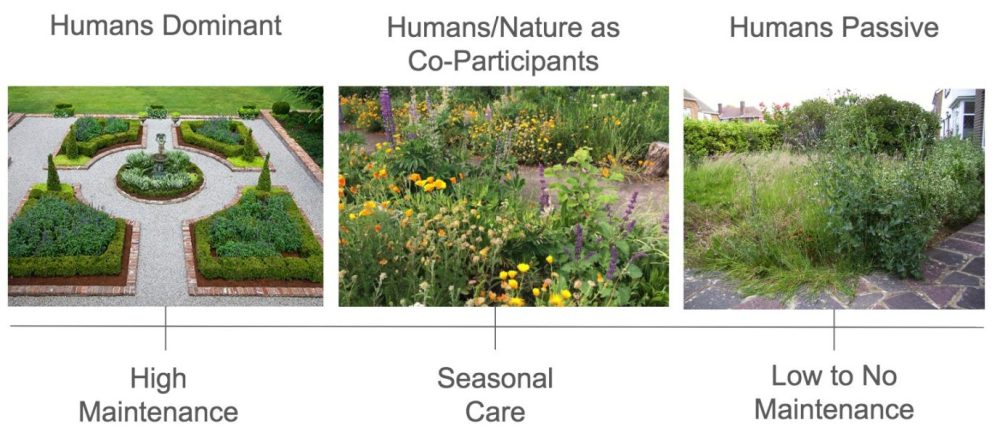If you like to step outside on summer days and see butterflies, birds and bees, then consider creating a patch in your garden for these critters. The main components of habitat are shelter, water, food and spaces to nest and rest. Winter is a great time to dream and design your garden habitat patch.
- Native plants provide food
All plants provide some shelter, but native plants provide both shelter and food in the form of leaves and blooms for many pollinators and other wildlife. Wherever you live, plants that are locally native will have the greatest number of relationships with native wildlife. They have evolved in partnership with each other over millennia. In short, native plants support the highest diversity of pollinators and other insects, and insects in turn feed the birds. In spring, most baby birds cannot eat seeds and need insects – caterpillars in particular, are like high-value protein bars for birds. While generalist pollinators like bumblebees benefit from a variety of introduced blooms, many native pollinators specialize on native plants. Native plants are the base of the local food web.
- Read your yard’s microclimates
The first step in any yard project is to understand the place you’re working with. A microclimate describes the conditions of sun exposure, soil moisture and heat or air movement in a particular spot. Identify where the sun rises (East) and sets (West), and note which direction the sun shines the strongest (South) and where shady spots might occur such as the North-facing side of your house. When it rains hard are there soggy spots, or does your yard drain pretty well? Does it get windy every afternoon, or extra hot near pavement? Note how the sun, water and wind generally move through an area.
- Know your priorities
Who are you gardening for? The act of gardening will benefit your well-being first and foremost, but do you have spaces primarily reserved for kids, pets, and gatherings? Do you have neighbors or Home Owner’s Associations to appease? What corners can you add plants for hummingbirds, native bees, honey bees, bats, chorus frogs or garter snakes? Depending on the size of your yard, you may not be able to meet everyone’s habitat needs, note who is already using your space and learn about the shelter, water and food they need.
- Locate your aesthetic
Without judgement, what amount of effort and time are you willing and able to give to a garden? You may love tidy, formal gardens (photo left), but they are high-maintenance. You may be better suited to a well-tended flower garden (center) or stand back and let the plants do as they will (right). Native plants will often thrive once their roots are established, but whether they grow into a complex forest or cottage garden is up to your aesthetic.

- The art and science of garden design
Deciding where to place plants is like putting a puzzle together. There are lots of ways to visualize plant placement – sketching ideas on paper, marking areas with stakes or sticks to represent each plant, or moving potted plants around until the puzzle comes together. Here are a series of considerations to get you started:
- How do you, your family, friends or dogs etc. move through your space? Carve out pathways to direct movement and take note that most animals including humans like to go direct.
- Identify zones or beds by micro-climates or watering needs, i.e. shady/dry soil or sunny/seasonally wet soil. Pick an area to focus on first in your yard.
- Where do you spend the most time looking at your outdoor spaces? Looking out from windows or a patio, identify sight lines or places where you might appreciate an evergreen to block the view, a bird bath as a focal point, or tall shrubs to break up a fence line. A well-placed tree or shrub can add depth and intrigue to your yard.
- Mark the spot with a stake, flag, stick or other marker to play with placement.
- Start with the tallest tree or plant, and research native species that will thrive in each zone’s micro-climate and fulfill your vision and habitat priorities. Note the average width and height.
- Measure the average width of potential trees in the space by marking it with a rope, hose or other visual marker. It’s very easy to plant things too close together!
- Once you know where there’s room for a tall tree or shrub it’s easier to imagine tucking small shrubs, ferns or flowers in around it. Draft a plant list by size.
- Check for bloom times, and plan for a variety of blooms that will feed pollinators all season.
- At the end of the day, after you’ve matched the watering and sunlight needs of a plant with a location, the rest is art. Have fun creating and let your inner knowing or sense of delight guide your plant composition.
6. Plan to plant in fall after the first rain and before the first frost, or early spring after the last major frost. This gives you a season or two of rain before you need to water in summer. More on watering next!
